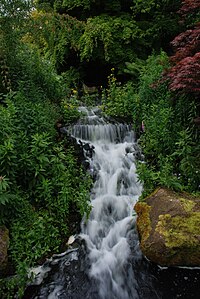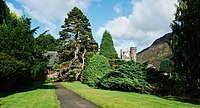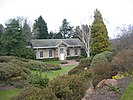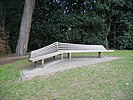Royal Botanic Garden Edinburgh: Difference between revisions
| Line 21: | Line 21: | ||
In 1763, the garden's collections were moved away from the city's pollution to a larger "Physick Garden" of five acres on the west side of Leith Walk, covering the area now called Bellevue, all under the control of Professor John Hope. This site is shown in Ainslie's 1804 map.<ref>{{cite web |url=https://maps.nls.uk/geo/explore/side-by-side/#zoom=17&lat=55.96127&lon=-3.18245&layers=126&right=BingHyb |title=Old and New Town of Edinburgh and Leith with the proposed docks. |author= John Ainslie|author-link= John Ainslie |date= 1804 |work=Town Plans / Views, 1580-1919 |publisher= National Library of Scotland |access-date=10 August 2020}}</ref> The site is today known as Hopetoun Crescent Gardens and is one of the collection of [[New Town Gardens]]. | In 1763, the garden's collections were moved away from the city's pollution to a larger "Physick Garden" of five acres on the west side of Leith Walk, covering the area now called Bellevue, all under the control of Professor John Hope. This site is shown in Ainslie's 1804 map.<ref>{{cite web |url=https://maps.nls.uk/geo/explore/side-by-side/#zoom=17&lat=55.96127&lon=-3.18245&layers=126&right=BingHyb |title=Old and New Town of Edinburgh and Leith with the proposed docks. |author= John Ainslie|author-link= John Ainslie |date= 1804 |work=Town Plans / Views, 1580-1919 |publisher= National Library of Scotland |access-date=10 August 2020}}</ref> The site is today known as Hopetoun Crescent Gardens and is one of the collection of [[New Town Gardens]]. | ||
Some time prior to Hope's death (1786) he was brought Turkish rhubarb seeds by | Some time prior to Hope's death (1786) he was brought Turkish rhubarb seeds by Bruce of Kinnaird and this was the first rhubarb grown in Great Britain.<ref>{{cite journal |url=https://www.rcpe.ac.uk/sites/default/files/jrcpe_47_1_lee.pdf |title=Rhubarb (Rheum species): the role of Edinburgh in its cultivation and development | last1=Lee |first1=MR |last2=Hutcheon |first2=J |last3=Dukan |first3=E |last4=Milne |first4=I |journal=Journal of the Royal College of Physicians of Edinburgh |year=2017 |volume=47 |issue=1 |pages=102–109 |doi=10.4997/JRCPe.2017.121|pmid=28569293 |doi-access=free }}</ref> As this proved successful over 3000 plants were grown as rhubarb was previously an expensive import (used as a medicine).<ref>{{cite book |title=Old and New Edinburgh|url=https://www.oldandnewedinburgh.co.uk/volume5/page173.html |author=James Grant|author-link=James Grant (1822–1887)|volume=5 |chapter=16 |page=173}}</ref> | ||
A cottage from the garden's original site remained on Leith Walk for over one hundred years. In 2008, the building was moved brick by brick to a site within the current gardens. The project was completed in 2016.<ref>{{cite news|url=https://www.edinburghnews.scotsman.com/news/georgian-leith-cottage-rebuilt-royal-botanic-garden-624306 |title=Georgian Leith cottage rebuilt at Royal Botanic Garden |work=Edinburgh Evening News |date=14 March 2016 |access-date=9 August 2020}}</ref> The garden was a popular destination for botanists and supplied plants to other gardens such as Kew Gardens|Kew. Hope erected a monument to Carl Linnaeus on the site in 1778.<ref>Grants Old and New Edinburgh</ref> | A cottage from the garden's original site remained on Leith Walk for over one hundred years. In 2008, the building was moved brick by brick to a site within the current gardens. The project was completed in 2016.<ref>{{cite news|url=https://www.edinburghnews.scotsman.com/news/georgian-leith-cottage-rebuilt-royal-botanic-garden-624306 |title=Georgian Leith cottage rebuilt at Royal Botanic Garden |work=Edinburgh Evening News |date=14 March 2016 |access-date=9 August 2020}}</ref> The garden was a popular destination for botanists and supplied plants to other gardens such as Kew Gardens|Kew. Hope erected a monument to Carl Linnaeus on the site in 1778.<ref>Grants Old and New Edinburgh</ref> | ||
Latest revision as of 20:45, 21 March 2022

The Royal Botanic Garden Edinburgh is a scientific centre for the study of plants, their diversity and conservation, as well as a popular tourist attraction. Founded in 1670 as a physic garden to grow medicinal plants, today the institutiopn is spread across occupies four sites, namely:
- The Edinburgh Botanic Garden;
- Dawyck Botanic Garden in Peeblesshire;
- Logan Botanic Garden in Wigtownshire;
- Benmore Botanic Garden (the Younger Botanic Garden) in Argyllshire
Each site has its own specialist collection. The living collection consists of more than 13,302 plant species (34,422 accessions),[1] while the herbarium contains in excess of three million preserved specimens.
The Edinburgh site is the main garden and the headquarters of the public body, which is led by Regius Keeper.
- Location: 55°57’54"N, 3°12’36"W
History
The botanic garden was founded in 1670 at St Anne's Yard, near Holyrood Palace, by Dr Robert Sibbald and Dr Andrew Balfour. It is the oldest botanic garden the United Kingdom after the University of Oxford Botanic Garden. The plant collection used as the basis of the garden was the private collection of Sir Patrick Murray, 2nd Lord Elibank, moved from his home at Livingston Peel in 1672 following his death in September 1671.[2] The original site was "obtained of John Brown, gardener of the North Yardes in the Holyrood Abby, an inclosure of some 40 foot of measure every way. By what we procured from Levingstone and other gardens, we made a collection of eight or nine hundred plants yr."[3][4][5]
This site proved too small, and in 1676 grounds belonging to Trinity Hospital were leased by Balfour from the City Council: this second garden was sited just to the east of the Nor Loch, down from the High Street. John Ainslie's 1804 map shows it as the "Old Physick Garden" to the east of the North Bridge. The site was subsequently occupied by tracks of the North British Railway, and a plaque at platform 11 of the Waverley railway station marks its location.[6][7]
In 1763, the garden's collections were moved away from the city's pollution to a larger "Physick Garden" of five acres on the west side of Leith Walk, covering the area now called Bellevue, all under the control of Professor John Hope. This site is shown in Ainslie's 1804 map.[8] The site is today known as Hopetoun Crescent Gardens and is one of the collection of New Town Gardens.
Some time prior to Hope's death (1786) he was brought Turkish rhubarb seeds by Bruce of Kinnaird and this was the first rhubarb grown in Great Britain.[9] As this proved successful over 3000 plants were grown as rhubarb was previously an expensive import (used as a medicine).[10]
A cottage from the garden's original site remained on Leith Walk for over one hundred years. In 2008, the building was moved brick by brick to a site within the current gardens. The project was completed in 2016.[11] The garden was a popular destination for botanists and supplied plants to other gardens such as Kew Gardens|Kew. Hope erected a monument to Carl Linnaeus on the site in 1778.[12]
In the early 1820s under the direction of the Curator, William McNab, the garden moved west to its present location (adjacent to Inverleith Row),[6][13] and the Leith Walk site was built over between Hopetoun Crescent and Haddington Place. The Temperate Palm House, which remains the tallest in Scotland, was built in 1858.
In 1877, the city acquired Inverleith House from the estate of Cosmo Innes and added it to the existing gardens, opening the remodelled grounds to the public in 1881.[14]
The botanic garden at Benmore became the first Regional Garden of the institution in 1929. It was followed by the gardens at Logan and Dawyck in 1969 and 1978.[15]
The garden at Edinburgh

The Botanic Garden's main site in Edinburgh is located one mile from the city centre and it covers 70 acres.[16]
The Garden is actively involved in, and coordinates numerous in situ and ex situ conservation projects both in Britain and internationally.
In addition to scientific activities, the garden remains a popular destination for both tourists and locals. Locally known as "The Botanics", the garden is a popular place to go for a walk, particularly with young families. Entrance to the botanic garden is free, although a small entry charge exists for the glasshouses. During the year the garden hosts many events including live performances, guided tours and exhibitions. The Garden is also an important centre for education, offering taught courses across all levels.
Living collection


Nearly 273,000[1] individual plants are grown at the Botanics in Edinburgh or its three smaller satellite or regional gardens. These represent around 13,300[1] species from all over the world, or about 4%[1] of all known plant species.
Some notable collections at the botanic garden Edinburgh include:
- Alpine Plants
- Chinese Hillside
- Cryptogamic Garden
- The Glasshouses
- Palmhouse
- Temperate Palms
- Tropical Palms
- Orchids and Cycads
- Ferns and Fossils
- Plants and people (including Giant Water Lily pond)
- Temperate lands
- Rainforest Riches
- Arid Lands
- Montane tropical house (including Carnivorous plants)
- Wet Tropical House
- Palmhouse
- Peat Walls
- The Queen Mother's memorial garden.
- Rock Garden
- Scottish Heath Garden
- Woodland Garden
Herbarium
The herbarium (situated in a purpose-built facility at the Edinburgh site) is considered a world-leading botanical collection, housing in excess of 3 million specimens. Prior to the formation of the Herbarium, plant collections tended to be the private property of the Regius Keeper. The Herbarium in its present form came with the fusion of the collections of the University of Edinburgh and the Botanical Society of Edinburgh in 1839–40. The Herbarium moved into its present, purpose-built home in 1964.
Over the years, a large number of collections have been added, belonging to individuals such as R.K. Greville and John Hutton Balfour, and institutions including the Universities of Glasgow, St Andrews and Hull. The most important historical collection is that of George Walker Arnott, which came with the University of Glasgow's foreign herbarium deposited on permanent loan in 1965. This collection contains specimens from all the major mid-19th century collectors, especially from India, North and South America, and South Africa, including type material of species described by ‘Hooker & Arnott'. From the early 20th century, collections have been made by members of staff.
The approx 33% of the herbarium that has been databased is on a searchable cataogue,[17] which is used when citing housed specimens.
Library
The Library houses around 70,000 books and 150,000 periodicals: one of the country's largest. It has been built up to support the specific subject fields researched and taught at Royal Botanic Garden. Garden staff and students are its main users, along with visiting researchers. As a national reference collection, the Library is also open to members of the public.
Inverleith House
Inverleith House is an 18th-century building, located centrally in the modern botanic gardens. From 1960 to 1984 it was the original base of the Scottish National Gallery of Modern Art, with exhibits in the house and in the gardens, before it moved to larger premises in Belford Road. Since then, Inverleith House has functioned as a contemporary art gallery, showing a programme of temporary exhibitions by invited artists. Its spring programmes feature works and specimens from the historical collections of the Botanics, together with exhibitions by modern and contemporary artists. The gallery is curated by the Royal Botanic Garden Edinburgh.[18]
Regional specialist gardens
Benmore
- Main article: Benmore Botanic Garden

In Argyllshire, Benmore Botanic Garden experiences a wetter and milder oceanic climate than the main site in Edinburgh. Benmore grows trees and shrubs from high rainfall areas, especially conifers and rhododendrons. Highlights of the collection include an avenue of Sequoiadendron and a recently refurbished Fernery, exhibiting rare ferns from both Britain and abroad.
Dawyck
- Main article: Dawyck Botanic Garden
To the south of Peebles in Peeblesshire, Dawyck Botanic Garden is particularly suitable for hardy plants from the world's cooler, drier areas. Dawyck is also renowned for its high diversity of fungi and cryptogamics.
Logan
- Main article: Logan Botanic Garden

Logan in Wigtownshire is the most exotic of the gardens: its position on the Rhinns of Galloway where an arm of the Gulf Stream hits the land has an almost sub-tropical climate, and provides ideal growing conditions for southern hemisphere plants.
Pictures
-
The Rock Garden, circa 1990
-
Trees in autumn
-
Inverleith House
-
View of the pond
-
East Gate of the Garden
-
West Gate entrance to the Garden
-
Caledonia Hall
-
Interior of the Palm House
-
Seat in Edinburgh Botanics
See also
Outside links
| ("Wikimedia Commons" has material about Royal Botanic Garden Edinburgh) |
- The Royal Botanic Gardens, Edinburgh
- The Living Collection catalogue
- Edinburgh Journal of Botany / Royal Botanic Garden Edinburgh at HathiTrust Digital Library
- Edinburgh Journal of Botany
- Botanical Scientific Journals
References
- ↑ 1.0 1.1 1.2 1.3 Rae D. et al. (2012) Catalogue of Plants 2012. Royal Botanic Garden Edinburgh. ISBN 978-1-906129-87-3
- ↑ William White (1889). Notes & Queries. Oxford University Press. https://books.google.com/books?id=SV4CAAAAIAAJ&q=patrick+murray%2C+baron+livingstone&pg=PA28.
- ↑ Hyam, Roger (10 February 2015). "How big was our garden?". Royal Botanic Garden Edinburgh. https://stories.rbge.org.uk/archives/13974.
- ↑ Sibbald, Robert. Manuscript Memoir. National Library Scotland. p. 22.
- ↑ Hett, Francis Paget (1932). The Memoirs of Sir Robert Sibbald (1641-1722). London: Oxford University Press. p. 65.
- ↑ 6.0 6.1 Dr M A Eastwood. "The Sibbald Physic Garden". Royal College of Physicians of Edinburgh. http://www.rcpe.ac.uk/library-archives/sibbald-physic-garden.
- ↑ John Ainslie (1804). "Old and New Town of Edinburgh and Leith with the proposed docks.". Town Plans / Views, 1580-1919. National Library of Scotland. https://maps.nls.uk/geo/explore/side-by-side/#zoom=17&lat=55.95230&lon=-3.18779&layers=126&right=BingHyb.
- ↑ John Ainslie (1804). "Old and New Town of Edinburgh and Leith with the proposed docks.". Town Plans / Views, 1580-1919. National Library of Scotland. https://maps.nls.uk/geo/explore/side-by-side/#zoom=17&lat=55.96127&lon=-3.18245&layers=126&right=BingHyb.
- ↑ Lee, MR; Hutcheon, J; Dukan, E; Milne, I (2017). "Rhubarb (Rheum species): the role of Edinburgh in its cultivation and development". Journal of the Royal College of Physicians of Edinburgh 47 (1): 102–109. doi:10.4997/JRCPe.2017.121. PMID 28569293. https://www.rcpe.ac.uk/sites/default/files/jrcpe_47_1_lee.pdf.
- ↑ James Grant. "16". Old and New Edinburgh. 5. p. 173. https://www.oldandnewedinburgh.co.uk/volume5/page173.html.
- ↑ "Georgian Leith cottage rebuilt at Royal Botanic Garden". Edinburgh Evening News. 14 March 2016. https://www.edinburghnews.scotsman.com/news/georgian-leith-cottage-rebuilt-royal-botanic-garden-624306.
- ↑ Grants Old and New Edinburgh
- ↑ "Great Reform Act Plans and Reports, 1832 - Edinburgh and Leith". Town Plans / Views, 1580-1919. National Library of Scotland. 1832. https://maps.nls.uk/geo/explore/side-by-side/#zoom=15&lat=55.96660&lon=-3.20810&layers=130&right=BingHyb.
- ↑ City of Edinburgh Council: Inverleith Conservation Area Character Appraisal p.8
- ↑ "Our History". Royal Botanic Garden Edinburgh. https://www.rbge.org.uk/about-us/our-history/.
- ↑ "Biodiversity Duty Report 2015-2017". Royal Botanic Garden Edinburgh. 31 December 2017. p. 4. https://www.rbge.org.uk/media/5466/rbge-biodiversity-duty-report-2015-2017.pdf.
- ↑ The Index Herbariorum
- ↑ "Inverleith House". Royal Botanic Garden Edinburgh. https://www.rbge.org.uk/whats-on/inverleith-house/.









